Erika Juhász – Edina Márkus – Balázs Benkei-Kovács: Investigation of the motivation and competencies of community organizer BA students in Hungary
Cikk letöltése: pdf2021-06-01

Abstract: The present study is focusing on the analysis of the results of a large-scale empirical research (n=730), gathered amongst the university Bachelor students of the community development degree program in Hungary. This university degree program, with 60 years of historical background, was relaunched in its complexity in the Hungarian Higher Education system in 2017, 12 years after the introduction of the Bologna system in the country. The paper is taking in consideration the results of the student’s motivation’s researches of other university study field (Brancu, L. – Munteanu, 2012. Martin – Sorhaindo et. al, 2014., Čukljek – Babi cet al. 2020). The realization of the investigation was following the logic of its national forerunner research, realized in relation to the pedagogy and andragogy bachelor programs in different Hungarian universities (Fónai-Kiss et. al, 2010; Kocsis-Mátrai-Zsolnai, 2007). This method is involving a complete assessment of the incoming students population, divided in four major thematic parts. Due to the complexity of assessment of the survey realized in multiple thematic blocs, we are focusing in the current study on those aspects which are interrelated with student motivation and carrier aspiration, linked together with the characteristics of incoming student’s excellence and performance. Beside the descriptive statistical analysis, we realized statistical significance crosstabulation analysis taking in consideration different factors (like gender or habitat), for discovering typical patterns amongst the student’s population. In summary, we can state, that the cohorts of students enrolling in 2017, 2018 and 2019 for the investigated bachelor program in Hungary, have improving learning community, with year by year stronger professional motivation.
In Hungary, the Bachelor degree courses in the field of culture and community education date back to the 1950s, 60 years ago. With the introduction of the Bologna higher education system, the Ministry of Culture did not start the independent Bachelor degree course for a short period of time (between 2006 and 2016). During this period, it was possible to acquire professional knowledge in the scope of an optional specialization (cultural organizer) of the Bachelor’s degree program of Andragogy, however, this three semester specialization could not exactly comply with content of the previous degree. As a result of the professional support of the Ministry, the demand of the labor market and the joint effort of academic specialists, the university bachelor's program in the field of culture and community education was relaunched in 2017. (Juhász-Pete 2018:44.) We aim to present the results of our nationwide representative survey conducted in the first three years after the restart, which, outlines the profile of the students applying for the new major, their professional motivation as well as their opinion and expectations regarding the prestige of the training.
The competences of university students and their expectations in their career choice, are examined from many aspects in the international literature. The question of motivation emerges from the topics of the international research on students (Brancu - Munteanu et al. 2012. Martin - Sorhaindo et. al. 2014., Čukljek - Babic et al. 2020), through which researchers in the field can monitor the factors of school enrollment, which is particularly important to be examined this when starting new types of training.
Our study aims to present the results of the survey of students majoring in community coordination (BA community organation, Bachelor's degree) since 2017, and summarize the most important experience of the first three years (2017–2019). The study endeavors to study the first-year students entering the program more thoroughly, so that both the higher education institutions and professionals can get a better picture of the characteristics of the new supply of students.
The study primarily explores the educational motivation, interests, labor values, and the vision of the students and also contains questions regarding the students' previous academic life, achievements, and socio-cultural background. The collection of data also aspires to assess the students' (reading and logic) skills when entering the course. The study sample covers the data of a larger national population (n=730).
Some of the preceding Hungarian research focuses on assessing the competencies of incoming students, analyzing the success factors for admission to university. Anlysis of the students with a similar function can be found, among others, in the works of Fónai – Kiss – Fábián (1999), Kocsis (2015), Reisz (2018) and Kocsis–Mátra–Zsolnai (2007 Another core group of research focuses on the output, often combining the investigation of students' career vision and labor market expectations with longitudinal measurements (e.g. Fónai 2018; Fónai – Márton 2018 Fónai – Kiss – Márton – Zolnai, 2010). This includes the group of research that focuses on attitudes towards the value and prestige of the university and the value of the university/university degree (Fábri 2014). The focus of the research varies depending on the size of the research groups, those focusing on one institution are more common, while national surveys are infrequent in Hungary. The present study attempts to combine the two main directions in a complex way: with national coverage, it combines the examination of input competence and the measurement of admission success factors with the methodology of attitude tests regarding the value and usability of the training.
Background and antecedents of the research
Getting to know the students' motivation and areas of interest is crucial to the effectiveness of the relaunched (2017) community coordination course. as it helps tailor the training content, venues for practices curricular and extracurricular content accordingly. For the success of the training, it is essential for the institutions to be aware of the students' sociocultural background and entrance competency levels. Training support services can be planned by taking the competence results into account (Juhász – Pete 2018). To be able to promote the university courses, it is useful to know what prior knowledge students have about them why they chose this major, how they got informed about them, what future plans the admitted students have All of these can also prevent dropout, which is now a serious challenge in higher education as well. (Pusztai – Fényes et al. 2019.)
The survey of the students participating in the previous teacher training at the University of Pécs in southern Hungary (Kocsis 2015) is considered to be a dominant antecedent of our research. Their data collection consisted of four parts: 1. exploration of the socio-cultural and socio-economic background of the students; 2. defining their current level of their reading comprehension skills; 3. the assessment of the current level of mathematical-logical thinking; 4. exploring the functional level of psychological immunocompetence. (Kocsis 2015:209) A total of 3,077 people filled in the questionnaire, but only those were included in the further processing who could be regarded as future teachers or those preparing for a career with a certain teaching related task. Their number was a total of 2,730.
Starting in the mid-1990s several research studies of Fónai (Fónai – Kiss – Fábián 1999, Fónai et al, 2010) examined the labor value of students in higher education, focusing primarily on the students of the University of Debrecen, but in some periods they also had the opportunity to conduct international comparative research.
The questionnaire serving as a research tool was prepared by the Community Culture Professional Development Working Group, which brings together the specialists of the universities involved in the restart of the training and the professional development staff of the National Institute of Culture.
We tried to reach as large a proportion of the total number of students as possible, and we registered high response rates in each examination year. (See Table 1.) The size of the research sample can be considered significant compared to previous studies in the field of motivation (Brancu, L. – Munteanu, V. et al., 2012. Martin – Sorhaindo et. al, 2014., Čukljek – Babic et al. 2020)
Table No. 1: The research sample - in the light of the number of BA students in Community Coordination
(Source:Author's editing based on research results and felvi.hu statistics)
|
Year of admission |
Number of people admitted at the national level |
Number of partiipants in the study |
proportion in the total sample |
|
2017 |
346 fő |
151 fő |
43 % |
|
2018 |
565 fő |
329 fő |
58 % |
|
2019 |
599 fő |
250 fő |
42 % |
The average age of the respondents among full-time students continuously decreased (2017 – 21.21 years; 2018 – 20.49 years; 2019 – 19.87 years), and it has approximately stayed the same among correspondence students (2017 – 30.33 years; 2018 – 29 .51; 2019 – 31.75 years). From the change we can draw conclusions about full-time students. While in the first two years it is more likely that those who apply to university later or those who change university majors, those looking for professional orientation were significant, in 2019 it was mainly studnts after high school studies, recent high school graduates, who chose the major of community coordination. This trend among full-time students is a strategically important indicator, as it can be interpreted as proof of the acceptance of the major and its successful social awareness
Research method and tools
The data collection of the survey is carried out annually during the autumn term, so it can also be suitable for following and measuring changes and trends in the medium run. In the first period, the data of the research was collected by filling out paper-based questionnaires. This method was replaced by digital data collection in the fall of 2020 due to the COVID-19 pandemic. The research sample data collection phase was assisted by the members of the Public Culture Professional Development Working Group, who had the questionnaires filled out in their own higher education institutionsThe data input into Excel spreadsheet was carried out by the staff of the National Institute of Culture. (The National Institute of Culture sent the already recorded institutional data to all participating higher education institutions in Excel and sav (SPSS) format for further processing, for local evaluation, development of the training as well as for competence development of the students.)
The complex measurement tool of the study consisted of two larger blocks: in the first block, students were questioned about the their background, results, and views (55 questions), and in the second part, the input competencies were assessed. Filling out the form took approximately 90 minutes.
- The most important thematic units of the first question block were the following:
- Social background variables, previous learning outcomes and study plans
- Motivations for the choice of major and profession, possible work experience
- Characteristics of socio-economic status and family background
- Use of leisure time, thinking patterns and professional vision
- Attitude and experience towards learning
The focus of the competency test was reading comprehension (24 questions), the examination of mathematical and logical skills (15 questions), and the psychological immunocompetence question block (80 questions).
The statistical analysis and processing of the results was carried out using Excel and SPSS database management softwares.
Thematic selection of the most important results of the research
In our study, we selectively present the results of the following topics from the entire research material:
- the motivation for choosing a major and work experience,
- student excellence and language skills,
- the assessment of the marketability of the major and key career factors,
- learning outcomes and learning attitudes.
In the case of the new university course launched in 2017, tit was of crucial importance to mapping student motivation (Figure 1). Following the general prestige motive in the first place (acquiring a university degree), in the second and third places we could find profession-specific factors that influenced studnets' decision to apply for admission: the interest in specialized subjects (57%) and the marketability of the professional qualification that can be obtained in the field (50%). A small part of the respondents chose this major because of the state financed program and the realistic chance of getting admitted. Among those who filled out the survey, only a small group of students had had previous professional experience in the field when they entered the university (7%), they are mainly correspondence students.
Figure 1.: Motivation for choosing the major (3 years' data aggregated/person)
(Source: Community coordination BA input competency test (2017–2019))
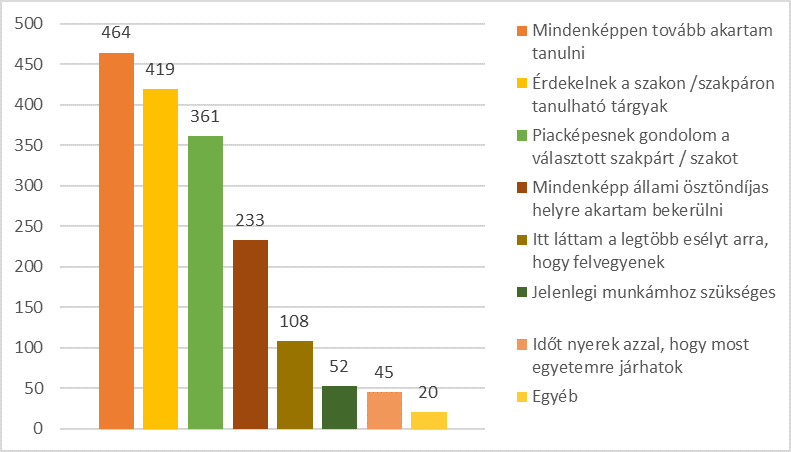
The excellence of the students of the major was basically assessed based on their language skills and their proactive behavior during their previous high school studies. The statistics of their participation in various competitions became an indicator of their pursuit of excellence. A smaller number of students studying in the program had previously participated in various types of academic, sports and art competitions (Figure 2). However, in 2019, the proportion of students characterized by excellence showed a definite increase in all the three areas and concerned more than a third of the participants in the survey. Activity in these areas can also be interpreted as a kind of promising indicator, as the experience gained in artistic or sports activities can be converted later into community activity initiatives (e.g. organizing community theater or sports events).
Figure 2: Emergence of student excellence
(Source: Community coordination BA input competency test (2017–2019))
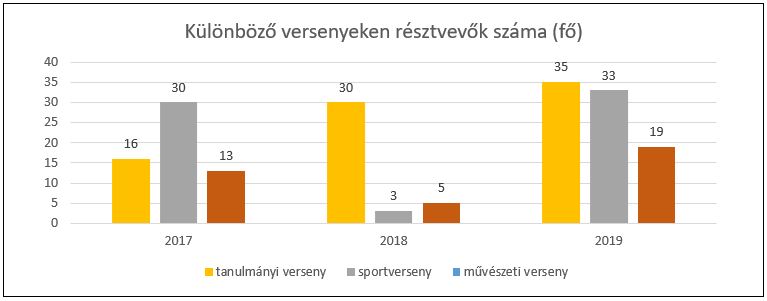
The number and proportion of those entering the university with a language certificate also supports the fact that a group of students with basically good abilities enrolled in the higher education courses of the community coordination BA major: regardless of the examined academic year, it can be stated that three-quarters of the first-year students have a language exam certificate (Figure no. 3). Higher education institutions can also build on this knowledge when organizing mobility programs and international projects.
Figure 3: Number of entrance language tests
Source: Community coordination BA input competency test (2017–2019)
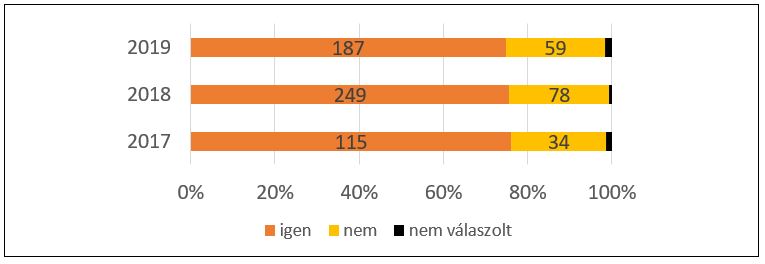
The reputation of the major is a particularly important aspect for us in terms of its relevance on the labor market (Figure 4). The national database of the Ministry of Education (www.felvi.hu) does not currently publish career tracking data related to the major, as the first yeargroup graduated in 2020. The results of national studies, which reflect the shortage of professionals in the labor market (Juhász – Pete, 2018), unfortunately were not published in the mainstream media, in contrast with, for example, the increased demand for IT professionals. Consequently, students obtained information from other sources about the labor market demand for the community coordination major graduates, the data of which are almost consistent to the results of research and surveys in the profession (Figure 4), and this is also reflected in the high number of applicants for the relaunched major. With its county network and its collaborations with the community culture professional networks the National Institute of Culture contributed greatly to measures taken to compensate for the shortage of professionals, the professional placement opportunities, and to the fact that he community culture higher education courses have become well-known.
Figure 4: Assessment of the marketability of the major
(Source: Community organization BA input competency test (2017–2019))
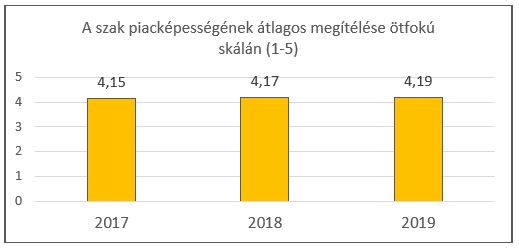
In response to the research question, the average point of the distribution of views between the two extreme values ("marketable" (5) and "not marketable" (1) range) is 4.18 points. As for the distribution of place of residence, the majority of respondents consider the profession to be marketable in all types of settlements. Respondents living in the capital have a more unified opinion on this issue, regarding the opinion of students from the country origin, we detected a more significant deviation in terms of the given value.
One of the most important points of the investigation was to specify which factors the students admitted to the program consider to be decisive in terms of successful career building at the very beginning of the training. In figure 5, based on the frequency of responses, persistence, social capital, university degree, studying, creativity, and diligence, as well as the appropriate financial background was put in the first cluster. (Out of the three factors that could be entered, the ones highlighted by the respondents in the first place in the period with the largest number of respondents (2018) have been included in figure No. 5. The figure was created with the https://wordart.com/ application.)
Figure 5: Factors identified and prioritized for a successful career
(2018, n=329 people) (Source: Community coordinationn BA input competency test (2017–2019)) 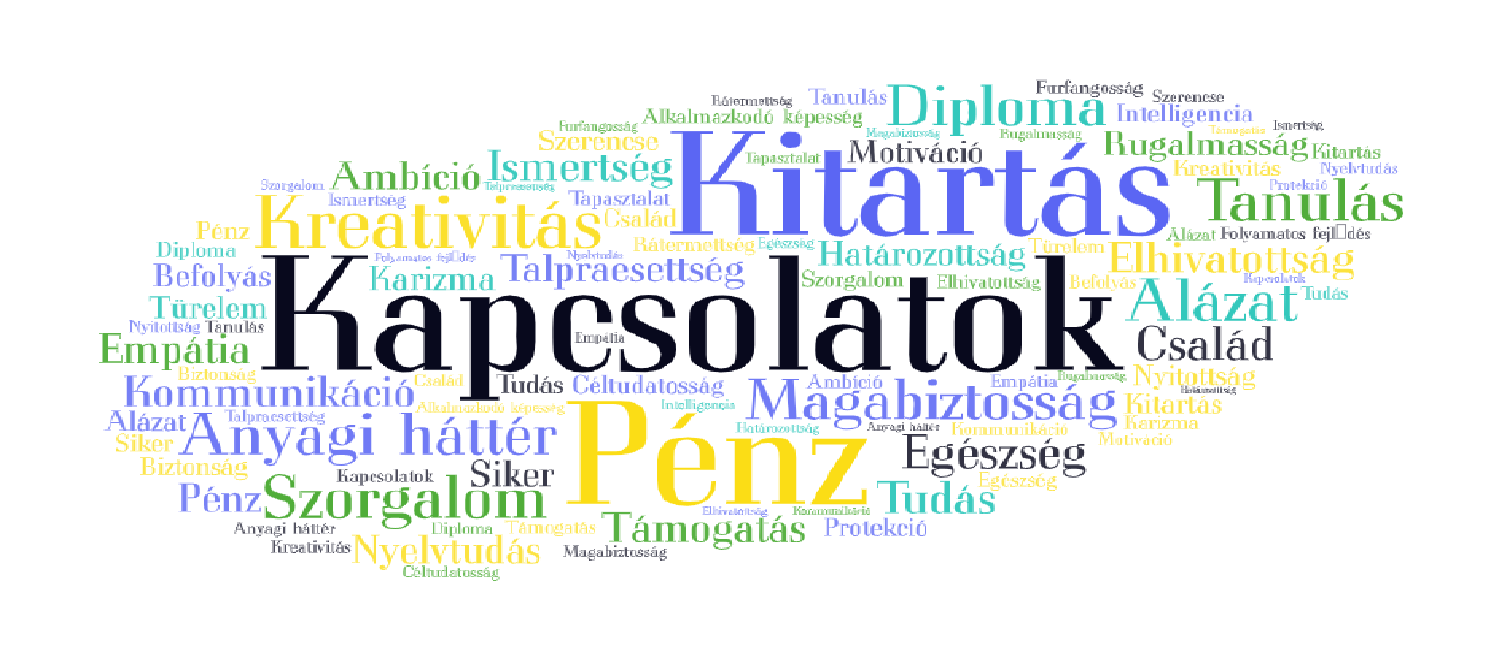 On the whole, the students precisely perceive the factors necessary for a successful professional career in the field of community coordination, which provides a good basis for providing anew supply of national professionals in higher education.
On the whole, the students precisely perceive the factors necessary for a successful professional career in the field of community coordination, which provides a good basis for providing anew supply of national professionals in higher education.
We consider examining the learning outcomes and learning attitudes of crucial because the students of the professional predecestor of the major (Andragogy BA basic course and cultural organization course) were admitted with lower input academic results. On the other hand, students of the cultural coordination BA course (Figure 6) have particularly strong academic results at the end of their high school studies (school leaving exam results range between 4.2 and 4.35). Based on their previous studying experience, they arrive at the universities with a significant amount of daily study hours (2.5-2.7 hours per day). This can also be considered a promising sign for a newly launched course, and places the responsibility on the university teaching community to use this capacity optimally for the sake of the appropriate learning outcome. Figure 6: Time spent studying and its effectiveness(Source: Community coordination BA input competency test (2017–2019))
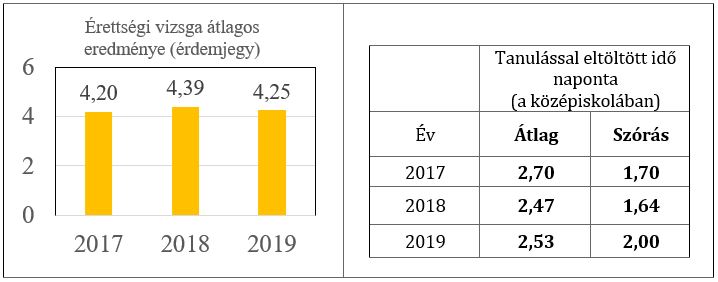
Despite their obvious studying capacity and workload performance, the general student attitude towards studying is somewhat ambivalent and not an entirely positive experience. They are in a tiny minority among the respondents for whom self-improvement is a compulsion or a burden (below 4%), and a significant proportion are represented by those students who enjoy studying less often (13-15%). For more than three-quarters of the participants, studying is a positive thing in most cases, an activity they gladly undertake, while 10 percent define studying as a source of pleasure.
Figure 7: Attitude developed in connection with studying experiences
(Source: Community coordination BA input competency test (2017–2019))
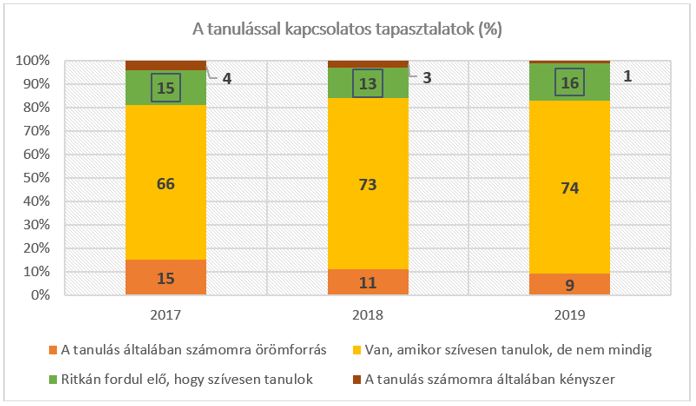
In the course of our data analysis, we endeavoured to explore statistically significant correlations of cross-variables of several parameters. In many hypothetical cases, we did not ultimately find any correlations, but some more interesting factors came to the light with the method of relational analysis:
More than a third of our female students (38%) answered that they would like to find a job as a community coordinator, while only a fifth of the male students (21%) answered the same way. Female students are therefore twice as committed in terms of their professional motivations.
At the same time, utilitarianism, i.e. the principle of usefulness, is more characteristic of our male students: a higher proportion of them joined the training (15%) as they already need to complete the bachelor’s program for their current job. In the case of women, this direct labor market need is lower: among them, less than a tenth of the students (8%) appear this need at the beginning of the training.
We discovered an interesting and important connection, which affects only a small proportion of the students. Those community coordination students who perform artistic activities daily, a significantly higher proportion said that the knowledge acquired in the major was necessary for their work (nearly 20%) than those. who do not perform such activities on a daily basis (values around and below 10% depending on the given answer options). They also have an advantage over their peers in terms of performing the complex task of community formation and tradition preservation.
We came to an interesting and important conclusion based on the type of residence and professional commitment. 41% of the students from municipalities and villages answered that they would definitely like to be a community coordinator when it comes to their professional commitment. This professional commitment rate deviates positively from the general trend. The result of this may later have a positive effect on solving the labor market shortage of community education specialists currently in Hungary, it is precisely the smaller settlements that are intensively struggling with this problem. (cf. Juhász – Pete 2018, 39).
Summary, suggestions
Based on the results, we can state that applicants for the community coordination major get admitted universities with good academic results, who also have a high final exam average and strong language skills. Their key professional motivation in relation to the training is placement in the labor market, they consider the major particularly marketable.
Our female students are typically twice as committed to career orientation when entering the program as their male counterparts. Students living in smaller settlements choose this profession much more consciously and with greater commitment. 17% of the students already have previous work experience, which is only partly related to the field.
In general, it can be stated that students in the major consider the degree as part of a successful career path. Their attitude to studying is somewhat ambivalent, not entirely positive in all respects, but they are a hard-working student community in terms of workload. A quarter of the first-year university students plan to continue their studies at a master's program, this proportion may increase during the course of training while they are getting acquainted with the professional content. In the future we plan to make the data collection and research continuous, so that we can constantly get a picture of the changes in the views of the students.
-
Brancu, L. – Munteanu, V. – Gligor D. (2012): Study on Student's Motivations for Entrepreneurship in Romania, in. Procedia - Social and Behavioral Sciences, Vol. 62, 223-231. p.Čukljek S. – Babic J et al. (2020): Reasons for Student Enrollment in Nursing Studies. In. Croatian Nursing Journal, Vol 4 (2), 183-191. p.
-
Fábri Gy. (2016): Az egyetem értéke - Felsőoktatási rangsorok és egyetemi teljesítmény. Budapest, ELTE Eötvös kiadó
-
Fónai M. – Kiss J. – Fábián G. (1999): Szociális munkás szakos hallgatók pályaképének néhány eleme. In: Esély 10. évf. 1. sz. 114 -134. p.
-
Fónai, M. – Kiss, J. – Márton, S. – Zolnai, E. (2010): Characteristics of the Work Value Choices of the University Students. In: Fedor, A – Semsei, I (eds): Twenty Years of Health Care Education and Social Sciences at the Faculty of Health Medical and Health Science Center University of Debrecen. Nyíregyháza: Faculty of Health Medical and Health Science Center, 38-60. p.
-
Juhász E. – Pete N. (2018): A közösségi művelődés képzési és továbbképzési rendszere. [Tudástár a közösségi művelődésben sorozat 1. kötet.] Budapest, Nemzeti Művelődési Intézet
-
Kocsis M. – Mátrai Zs. – Zsolnai J. (2007): Survey of the reading comprehension skills of first years student. IEAE 33rd annual conference, Baku, Azerbaiijan 16/9-21/9, 2007 (http://www.iaea.info/documents/paper_1162d2060d.pdf)
-
Kocsis M. (2015): A bemeneti kompetenciák vizsgálata pedagógusjelölt hallgatók körében. Pécs, Pécsi Tudományegyetem
-
Martin, H, Sorhaindo, C and Welch, F (2014) Motivation of undergraduate civil engineering students for higher levels of academic success. In: Raiden, A and Aboagye-Nimo, E. (Eds) Procs 30th Annual ARCOM Conference, 1-3 September 2014, Portsmouth, UK, Association of Researchers in Construction Management, 1205-1214. p.
-
Pusztai, G., Fényes, H., Szigeti, F., & Pallay, K. (2019). Dropped-out Students and the Decision to Drop-out in Hungary. Central European Journal of Educational Research, 1(1), 31–40.p. https://doi.org/10.37441/CEJER/2019/1/1/3341
-
Reisz Terézia (2018): Az egyetemre jutás sikertényezői. In. A felsőoktatási lifelong learning társadalmi és gazdasági haszna: kutatás – fejlesztés – innováció, Mellearn Konferenciakötet, Budapest, Mellearn Egyesület 114-134. p.
-
